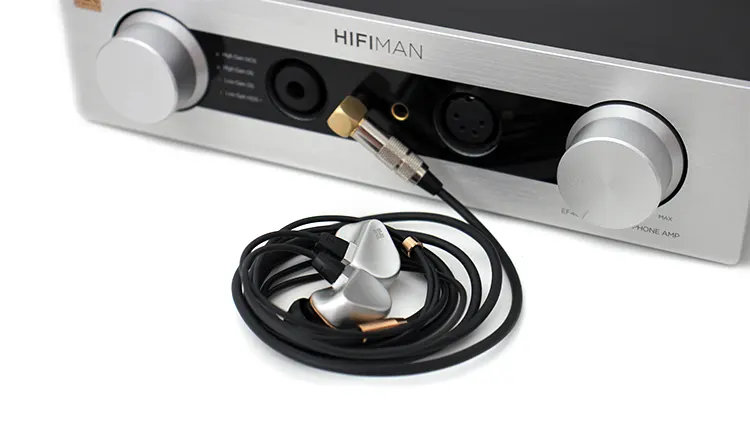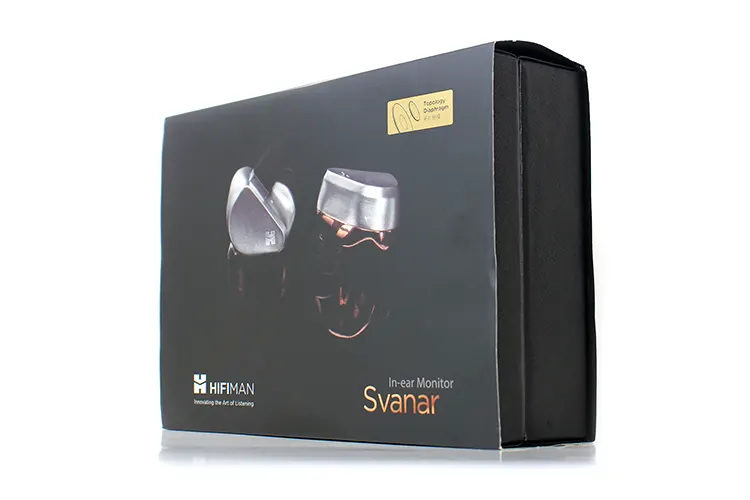Sound Impressions
Summary
The HIFIMAN Svanar IEMs are tuned to achieve a realistic tonality and balance but they also have a slight forwardness in their overall presentation and some would even categorize them as W-shaped in signature on a first listen.
That’s until you start getting smacked by the balance in tuning achieved which emerges after a long break-in period.
The bass region is bought forth and so is the midrange production. It’s a subtle elevation and tastefully done. The Svanar is one of the only IEM sets that I don’t have to play with a bass boost or similar because the bass quantity is just where I like it to be.
As I run a frequency sweep across the midrange I noticed there was a slight uprise above neutral in the mids above 2kHz. This adds some mid-presence, enhances detail production, and complements the bass nicely. Frequency response is mostly even however and veers only a couple of decibels here and there.
This topology driver seems to have one of the most perceivably frontal but balanced frequency response characteristics I’ve run through the tone generator sweep.
All the frequencies seem to be in balance including the high frequencies but they’re all a bit forward. I’m not complaining because it’s quite addictive and that fact is attributed to the quality of the output.
Bass
The Svanar has a luscious and accurate bass response that caters to quality over quantity although the bass gives off an ample amount of presence. It digs deep and has quite a nice punch when provoked. The overall speed of the driver is also top-notch.
The deep bass response starts to drop off around 22Hz but there’s plenty of energy above that. The deep bass has a lot of presence above 24Hz and it’s also most prominent below the midsection.
So just imagine a solid bottom end and a relatively neutral midbass response. This produces an unbloated character with a solid bottom end.
Although the bass is punchy, hard-hitting, and deep-reaching, the Svanar encourages you to look for tracks that demonstrate the quality over quantity aspect of bass which is where I would put them categorically far as bass production.
Accurate bass over everything else is what they seem to aim for. They sure can party hard but are best at musicality.
Midrange
The vocal presentation is one of Svanar’s highlights and the midrange just exudes detail. It’s a bit forward but buttery smooth, and soothing while simultaneously projecting an ample amount of presence.
The forwardness doesn’t seem to bring forth a shouty character and just comes at you in a rather unveiled form.
I would categorize the midrange as intimate especially when it comes to vocals and wind instruments and one could say there’s an introverted characteristic to it. They seem close-up and personal, a musical hug.
A true tone character emerges with instruments like Piano which are hard to reproduce properly. Each note is distinct and that characteristic also applies to vocal choruses in which you can distinctly pick out each participant on the line.
Treble
The treble response could well be some of the best highs I’ve heard on a single-driver IEM or any other IEM. There is a slight forwardness to them, once again, but their definition is sharp, crisp, and very well-defined.
The Svanar highs are produced with a meaty character that gives each note weight and a real-life presence, and detail.
The treble response is sweet and precise. There’s a good sense of realistic drumsticks, tapping snares, and top hat production. The high frequencies have a good ability to project fast, coherent, and speedy highs that never get harsh or stray into sibilance but are not shy to project sound.
Timbre
Tonality overall is what I call truetone where there’s plenty of realism perceived especially with vocals, wind instruments, and other sounds that run within the midrange bands. The high frequencies follow suit with plenty of coherent presence and a very realistic timbre.
One small warning, the Svanar reveals mistakes and anomalies within recordings, and at times you might think there’s a flaw in the presentation when in fact, all along it was revealing something you never heard before. This is a good IEM for people who want a high level of detailed reproduction.
The cherry on top is, in fact, the detail production itself. If you want to hear the entire extended resonant note within that silent section near the end of Stevie Wonder’s “Vision” track then these are for you. Or if you want to hear breath and lip-smacking on Andy Scauf’s newest tracks, again these are for you.
The Svanar tries to reveal everything within recordings and does a good job at it. You could say it’s one of its strong points.
Staging & Dynamics
The HIFIMAN Svanar has plenty of attack and energy behind its sweet-sounding and energetic signature. Snares sound peppy and bass drums give off a good wallop. The best part of drum tracks on the Svanar, for example, is that you can sense where those drumsticks are at. This is a very technically capable IEM.
There seems to be plenty of precision within the soundstage but I wouldn’t consider the general characteristic as very wide and more introverted with a realistically sized soundstage that can project anywhere in a 4-dimensional sense that covers the front, back, sides, and height.
The overall stage size is not very wide and large but a realistic one that lets you pick out and make sense of every sound within a recording.
There’s a bit of intimacy in that width that doesn’t go far out but is contrary to the depth which is covered from ear to ear and through the front of the listener’s panorama and with ample height.
Genre Pairing
I could recall lots of realism in Pink Floyd’s wake-up alarms at the beginning of the track Time. I could sense the metallic ring.
At the same time, I heard other details that I haven’t heard before. Now I know why the Dark Side of the Moon is so revered by audiophiles. It’s because you need good gear to hear all the small details and the Svanar is up to the task.
They have an unveiled characteristic indeed. But they also can produce piano timbre correctly and many other instruments that are difficult to get right. Wind instruments are presented with so much detail that you can hear the pre-breath, and the occasional valve flapping.
If you listen to some Classical music or music that’s complex that has many elements then you can also distinguish what’s there. In other words. The Svanar is not genre specific and gives off an accurate, albeit musical representation.
Synergy
Efficiency
The Svanar is very efficient but one thing I noticed was their ability to tighten up when you use gear that is adequately endowed with plenty of driving power.
I wouldn’t worry so much far as power but I would just feed them clean power, plain and simple. The cleaner, the better, and, it seems the source is more important in their case particularly.
Pairings
The HIFIMAN Svanar IEMs have an uncanny ability to show off an amplifier’s ability far as fidelity. They reveal the quality level of the component.
I started with a couple of dongle DACs. I pulled out the FiiO KA3 and the iFi Audio GO Bar and heard clear sonic differences. But it wasn’t until I broke out the HIFIMAN EF400 that I got a hit of Svanar’s abilities. It happened even more so with the iFi Audio iDSD Diablo.
If you’re very detail-oriented, you will notice that all the gear I used with the Svanar lacks any sound-altering features and are devices that are considered flat and neutral. The Svanar likes that because their tonality is a complete package and they don’t need boosting or reduction in any area.
Select Comparison
HIFIMAN RE2000 Gold Edition
$2000.00
Technical
The HIFIMAN RE2000 has many similarities to the Svanar. It uses a similar single 9.2mm Topology coated dynamic driver but if you take a glance at the specifications you can tell some things have changed.
For example, the frequency response was widened on the Svanar from 5 to 20kHz to a more ample 5 to 35kHz improving on high-frequency extension. Another specification that changed was the sensitivity rating which went down on the Svanar to 100dB versus the RE2000 which received a 103db rating.
One aspect I found curious about the RE2000 is that the price tag matches the product model number. In that case, Id surely wished they would have called them the RE20 but there’s no chance of that happening especially with the gold plating implementation.
Design
At a glance, these two IEMs are very different. It’s quite obvious we could say the Svanar shell construction uses a composite body style but what do you call the shape of the RE2000? The funny thing is that the shape works far as comfort although it’s surely not a common shape.
The packaging seems almost identical but the RE2000 seems more generous far as accessories. You get 2 cables and 3.5mm plus 4.4mm connectivity, plus you get 2 sets of the H connectors instead of one set.
Performance
To be fair, I used both IEMs with their supplied single-ended cable since they seem to be the same assembly. I mostly used the HIFIMAN EF400 and the iFi Audio iDSD Diablo plus their NEO iDSD desktop DAC amplifier. I also used a couple of dongle DACs like the FiiO KA3 and the iFi Audio GO Bar.
It’s a good idea to revisit your old gear because sometimes you’ll find that your judgment changed or you find a new synergy that works with the particular gear.
Somehow I had my head programmed to remember a thinner sound signature from the RE2000. I pulled them out, plugged them into my Diablo, and was greeted with warmth although the Diablo could sound bright at times. So it might have been the gear they were plugged in back when I got them that gave off that impression.
Bass
I found both these IEMs to have a reverse effect while breaking in. The Svanar was heavy-handed in the bass at first and they somehow tightened up plenty while the RE200 is the opposite. They start bass light and bass output increases with time.
The bass is produced with a heavier presence on the RE2000 and is more inclined to manifest a midbass rise more so than the lower portions of the bass where the Svanar excels. The bass seems leaner and faster responding on the Svanar.
If you compare the two shell designs, the larger one seems to be the RE2000 shell and that can explain away the almost cavernous and large bass you get from the RE2000 but that aids in obtaining a party-type bass response that might suit a bass-head best.
Midrange
The midrange seems pushed back some on the RE2000. The Svanar is more aggressively tuned in the fact that they seem more forward-projected but they also project more detail.
They both have a smooth character and some might prefer the more laid-back presentation of the RE2000 because they do tend to sound more soothing, however, realism is best presented on the Svanar.
But the devil is in the detail as they say and the Svanar excels in this category over the RE2000. There’s a detail retrieval aspect that seems to be improved almost two-fold and it seems a layer of the audio veil in hardware limitation has been lifted on the Svanar.
Treble
The treble response is darker on the RE2000 but somehow it kept the same positioning and space the highs occupy in the sonic panorama and with similar weight. They both project clean high frequencies but the Svanar seems more confident, more focused, and just has a better-defined and upfront tonality.
I also like the weightiness of the notes off the Svanar. They also give off a more realistic bite and better high-frequency resolution overall.
Staging
The staging is certainly taller and there’s more micropositioning on the Svanar but I would have to give the RE2000 the win on overall soundstage size. They just project a larger panorama.
The Svanar has an introverted, personal character that works best with vocal production and it brings things up close. But that doesn’t mean they lack soundstage because precision-wise they take the win hands down with better micropositioning.
They also give off a better sense of the recording area and at times can produce reverberation and harmonics included within the recordings and which give off a better sense of the overall presentation and give off a more complete picture in general.
Our Verdict
I have a love-and-hate relationship with the HIFIMAN Svanar because since I got them I haven’t been able to take them off and they also spoiled me to the point where my other dozens of IEMs will be gathering dust from now on.
The HIFIMAN Svanar might lack an upgraded accessory package, but they certainly don’t lack sound quality. Their overall sound is addictive, intimate, and inviting, and it will be a hard task if you embark on a search for a better-sounding IEM.
HIFIMAN Svanar Technical Specifications
- Frequency Response: 5Hz to 35kHz
- Impedance: 60Ω
- Sensitivity: 100db
- Weight: 13g excluding cable
- Physical Attributes: 9.2mm Dynamic Topology Diaphragm driver







